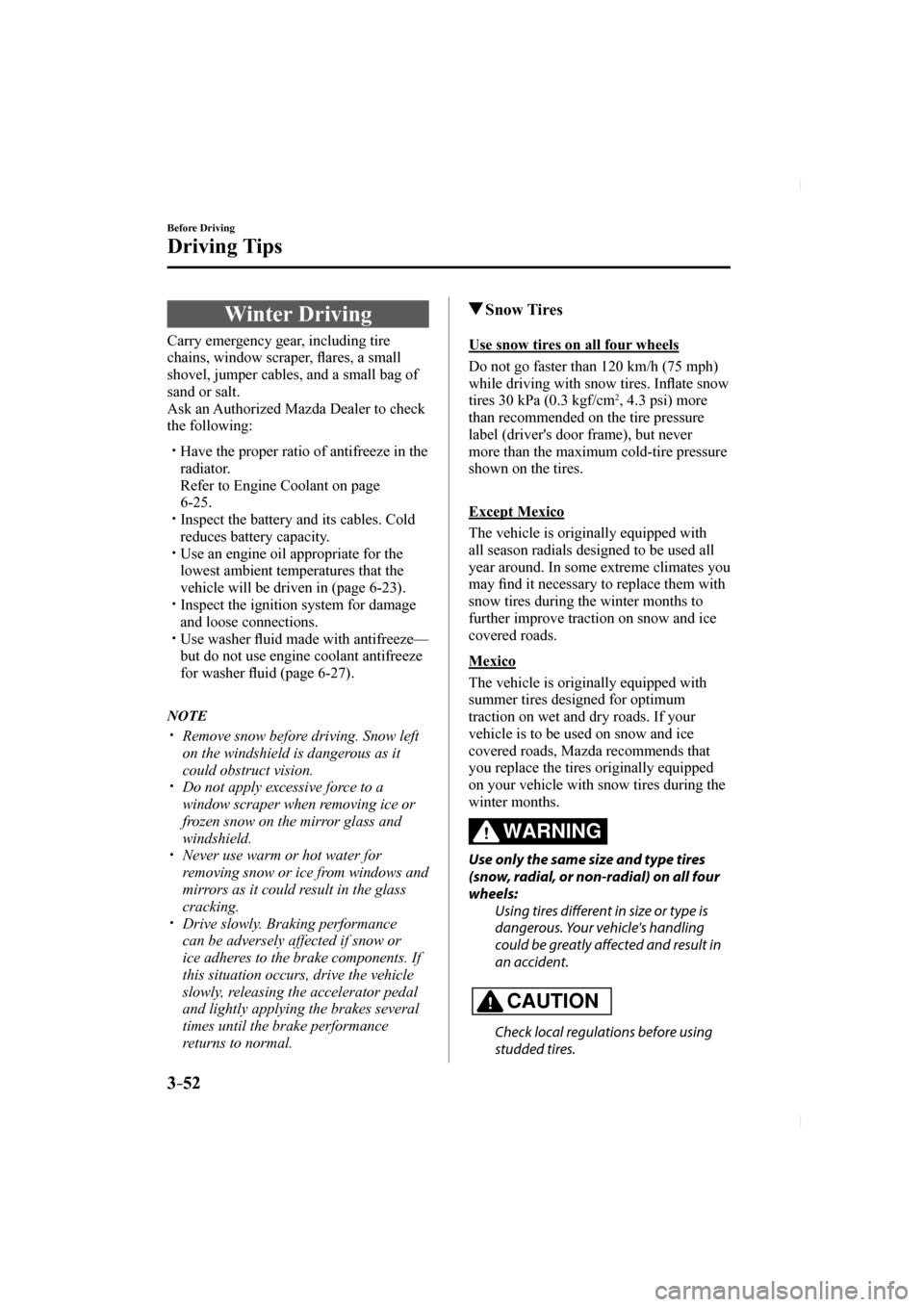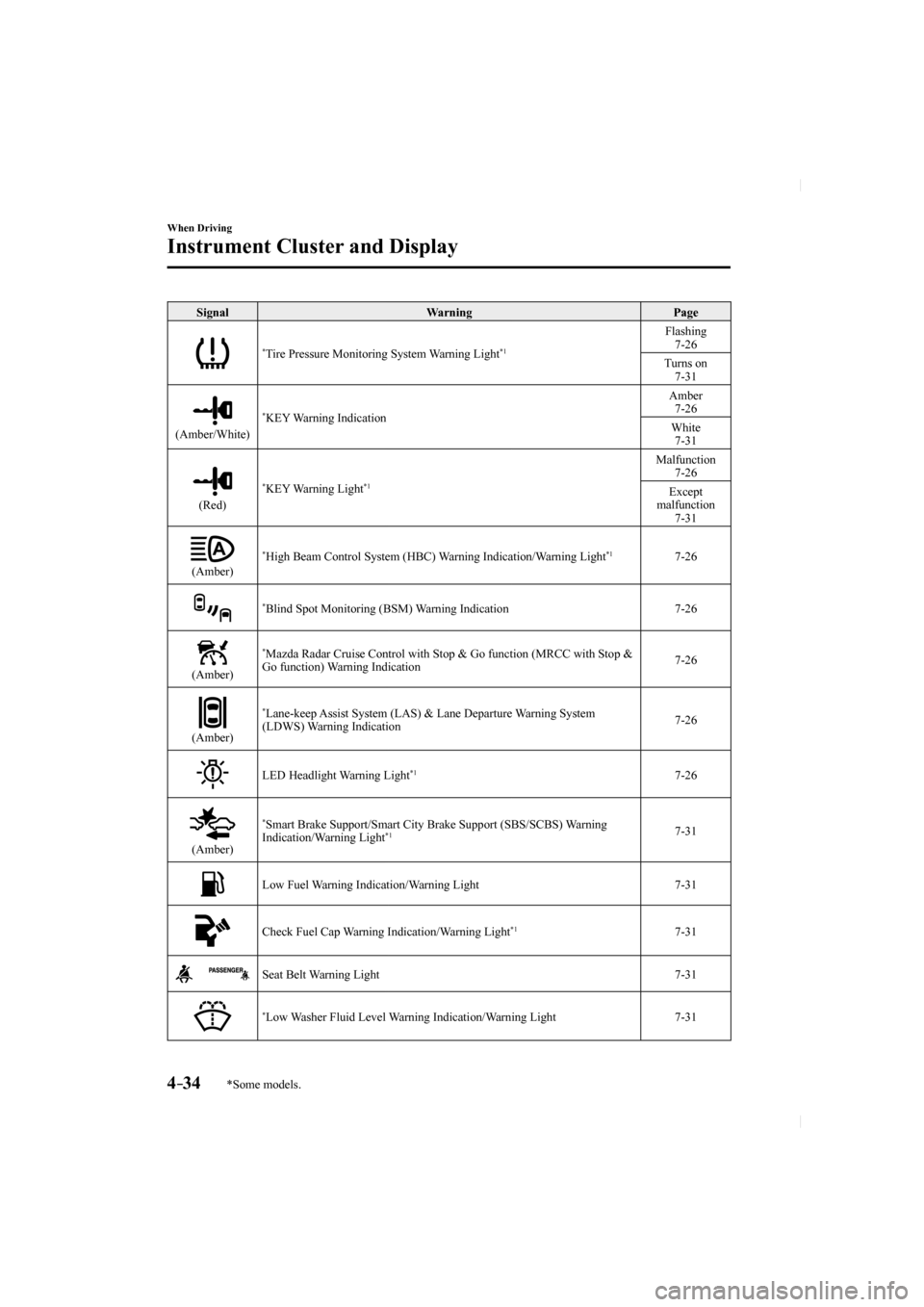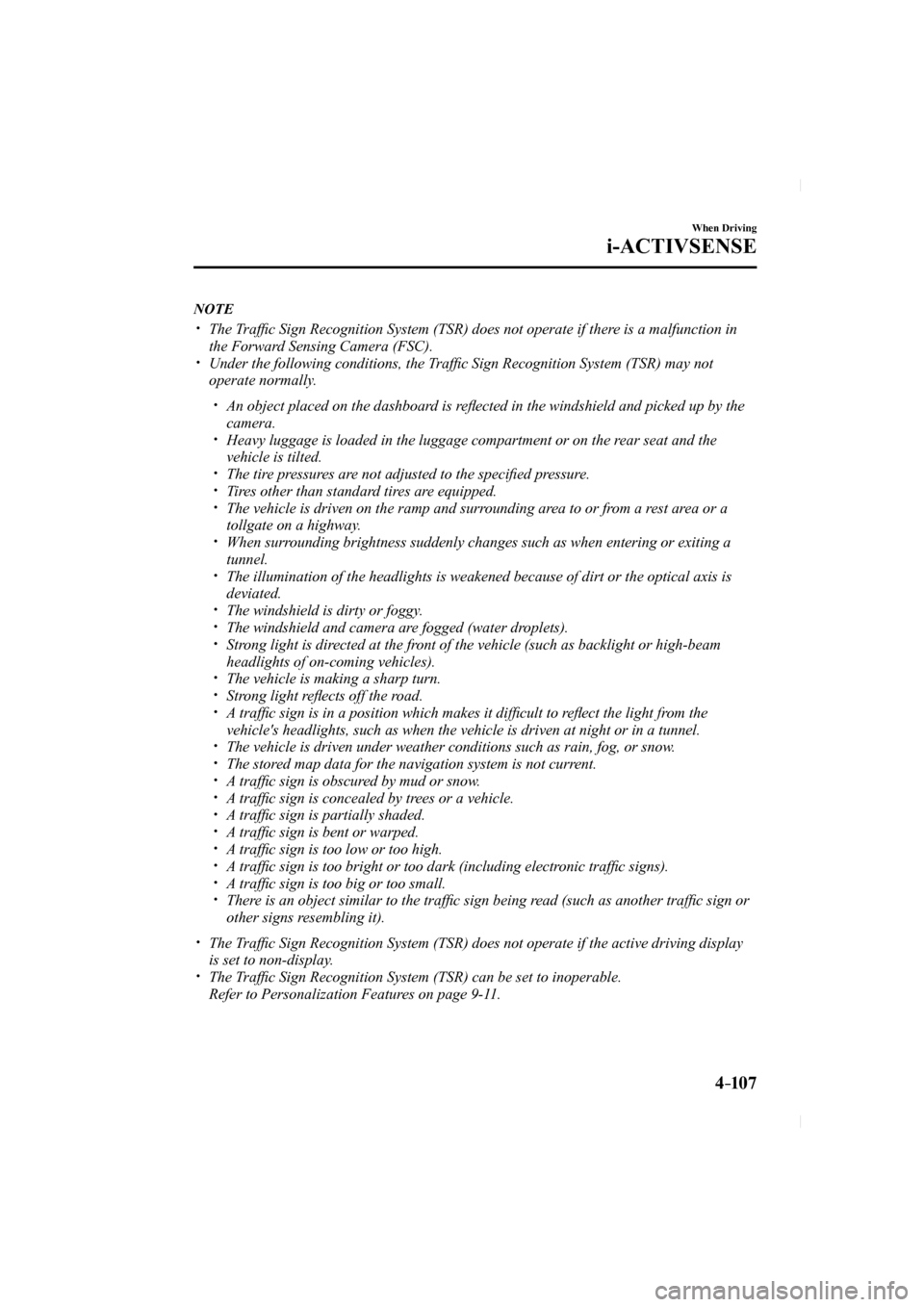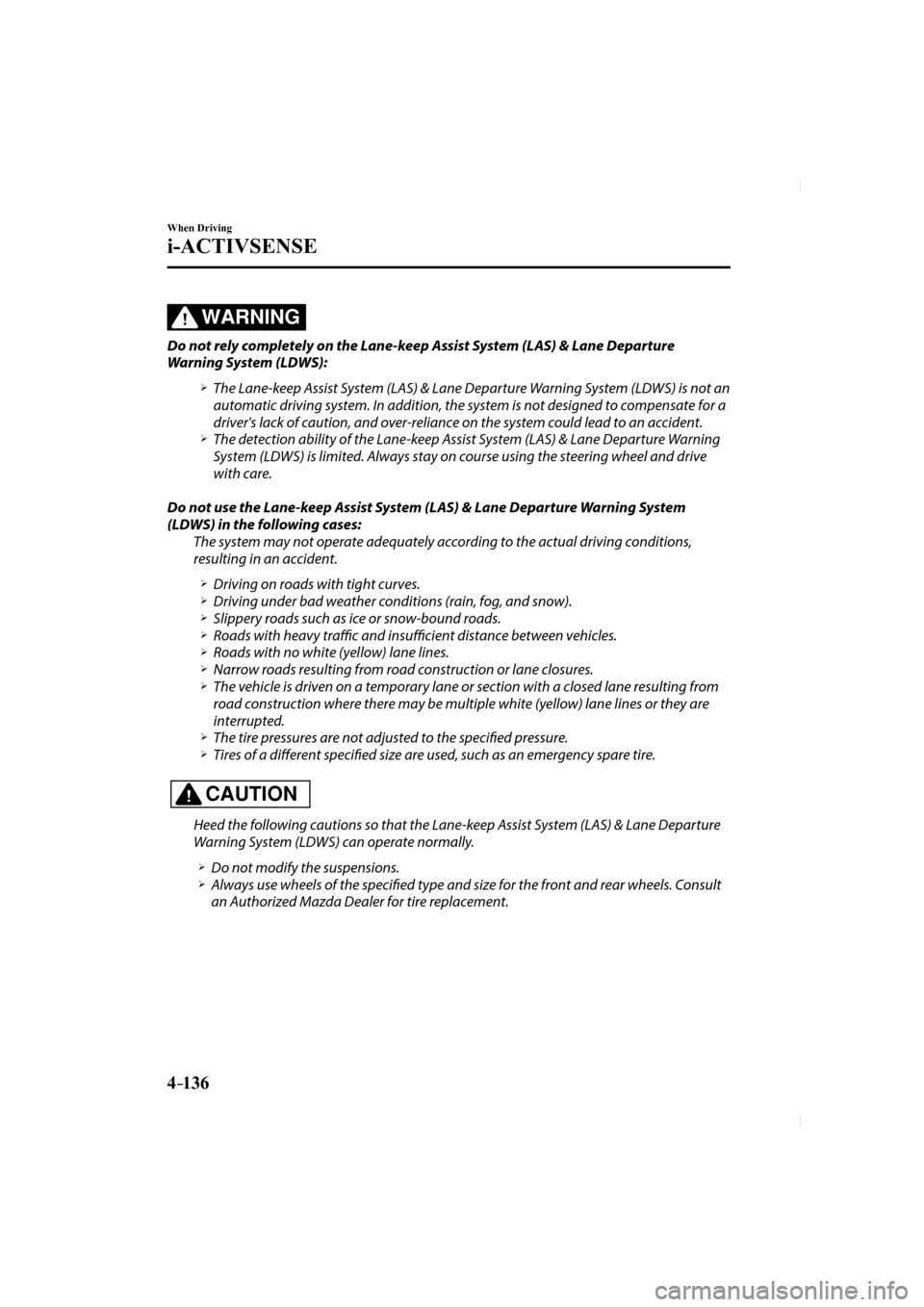tire pressure MAZDA MODEL CX-5 2017 Owners Manual (in English)
[x] Cancel search | Manufacturer: MAZDA, Model Year: 2017, Model line: MODEL CX-5, Model: MAZDA MODEL CX-5 2017Pages: 664, PDF Size: 11.73 MB
Page 64 of 664

2–50
Essential Safety Equipment
SRS Air Bags
To prevent false detection by the air bag sensor system, heed the following: Do not use tires or wheels other than those specifi ed for your Mazda: Use of any tire or wheel other than those specifi ed for your Mazda (page 9-9 ) is dangerous. Use of such wheels will prevent the vehicle's accident detections system
from accurately detecting a collision or roll-over accident resulting in incorrect or
unexpected air bag deployment and the possibility of serious injuries.
Do not overload your vehicle: Overloading your vehicle is dangerous as it could prevent the air bag crash sensor system from accurately detecting a collision or roll-over accident resulting in incorrect
or unexpected air bag deployment and the possibility of serious injuries. The gross axle
weight rating (GAWR) and the gross vehicle weight rating (GVWR) for your vehicle are
on the Motor Vehicle Safety Standard Label on the driver's door frame. Do not exceed
these ratings.
Do not drive the vehicle off -road: Driving your Mazda off -road is dangerous because the vehicle has not been designed
to do so. Driving the vehicle off -road could prevent the air bag crash sensor system
from accurately detecting a collision or roll-over accident resulting in incorrect or
unexpected air bag deployment and the possibility of serious injuries.
Do not modify a front door or leave any damage unrepaired. Always have an
Authorized Mazda Dealer inspect a damaged front door: Modifying a front door or leaving any damage unrepaired is dangerous. Each front
door has a side crash sensor as a component of the supplemental restraint system. If
holes are drilled in a front door, a door speaker is left removed, or a damaged door is left
unrepaired, the sensor could be adversely aff ected causing it to not detect the pressure
of an impact correctly during a side collision. If a sensor does not detect a side impact
correctly, the side and curtain air bags and the front seat belt pretensioner may not
operate normally which could result in serious injury to occupants.
Do not modify the supplemental restraint system: Modifying the components or wiring of the supplemental restraint system is dangerous.
You could accidentally activate it or make it inoperable. Do not make any modifi cations
to the supplemental restraint system. This includes installing trim, badges, or anything
else over the air bag modules. It also includes installing extra electrical equipment on or
near system components or wiring. An Authorized Mazda Dealer can provide the special
care needed in the removal and installation of front seats. It is important to protect the air
bag wiring and connections to assure that the bags do not accidentally deploy, and that
the front passenger occupant classifi cation system and the seats retain an undamaged
air bag connection.
CX-5_8FN1-EA-16L_Edition1.indb 502016/12/12 10:05:24
Page 132 of 664

3–52
Before Driving
Driving Tips
Winter Driving
Carry emergency gear, including tire
chains, window scraper, fl ares, a small
shovel, jumper cables, and a small bag of
sand or salt.
Ask an Authorized Mazda Dealer to check
the following:
Have the proper ratio of antifreeze in the
radiator.
Refer to Engine Coolant on page 6-25 .
Inspect the battery and its cables. Cold
reduces battery capacity.
Use an engine oil appropriate for the
lowest ambient temperatures that the
vehicle will be driven in (page 6-23 ).
Inspect the ignition system for damage
and loose connections.
Use washer fl uid made with antifreeze—
but do not use engine coolant antifreeze
for washer fl uid (page 6-27 ).
NOTE
Remove snow before driving. Snow left
on the windshield is dangerous as it
could obstruct vision.
Do not apply excessive force to a
window scraper when removing ice or
frozen snow on the mirror glass and
windshield.
Never use warm or hot water for
removing snow or ice from windows and
mirrors as it could result in the glass
cracking.
Drive slowly. Braking performance
can be adversely affected if snow or
ice adheres to the brake components. If
this situation occurs, drive the vehicle
slowly, releasing the accelerator pedal
and lightly applying the brakes several
times until the brake performance
returns to normal.
Snow Tires
Use snow tires on all four wheels
Do not go faster than 120 km/h (75 mph)
while driving with snow tires. In fl ate snow
tires 30 kPa (0.3 kgf/cm
2 , 4.3 psi) more
than recommended on the tire pressure
label (driver's door frame), but never
more than the maximum cold-tire pressure
shown on the tires.
Except Mexico
The vehicle is originally equipped with
all season radials designed to be used all
year around. In some extreme climates you
may fi nd it necessary to replace them with
snow tires during the winter months to
further improve traction on snow and ice
covered roads.
Mexico
The vehicle is originally equipped with
summer tires designed for optimum
traction on wet and dry roads. If your
vehicle is to be used on snow and ice
covered roads, Mazda recommends that
you replace the tires originally equipped
on your vehicle with snow tires during the
winter months.
WARNING
Use only the same size and type tires
(snow, radial, or non-radial) on all four
wheels: Using tires diff erent in size or type is
dangerous. Your vehicle's handling
could be greatly aff ected and result in
an accident.
CAUTION
Check local regulations before using
studded tires.
CX-5_8FN1-EA-16L_Edition1.indb 522016/12/12 10:05:38
Page 133 of 664

3–53
Before Driving
Driving Tips
Tire Chains
Check local regulations before using tire
chains.
CAUTION
Chains may aff ect handling. Do not go faster than 50 km/h
(30 mph) or the chain manufacturer's
recommended limit, whichever is lower.
Drive carefully and avoid bumps, holes, and sharp turns.
Avoid locked-wheel braking. Do not use chains on a temporary spare tire; it may result in damage to the
vehicle and to the tire.
Do not use chains on roads that are free of snow or ice. The tires and chains could
be damaged.
Chains may scratch or chip aluminum wheels.
NOTE
If your vehicle is equipped with the tire
pressure monitoring system, the system
may not function correctly when using tire
chains.
Install the chains on the front tires only.
Do not use chains on the rear tires.
Please consult an Authorized Mazda
Dealer.
Installing the chains
1. Secure the chains on the front tires as tightly as possible.
Always follow the chain manufacturer's instructions.
2. Retighten the chains after driving 1/2—1 km (1/4—1/2 mile).
Driving In Flooded Area
WARNING
Dry off brakes that have become
wet by driving slowly, releasing the
accelerator pedal and lightly applying
the brakes several times until the brake
performance returns to normal: Driving with wet brakes is dangerous.
Increased stopping distance or the
vehicle pulling to one side when
braking could result in a serious
accident. Light braking will indicate
whether the brakes have been aff ected.
CAUTION
Do not drive the vehicle on fl ooded
roads as it could cause short circuiting
of electrical/electronic parts, or
engine damage or stalling from
water absorption. If the vehicle has
been immersed in water, consult an
Authorized Mazda Dealer.
CX-5_8FN1-EA-16L_Edition1.indb 532016/12/12 10:05:38
Page 139 of 664

3–59
Before Driving
Towing
Trailer Hitch
Use only a hitch ball recommended by the trailer manufacturer that confo\
rms to the gross
trailer weight requirement.
When not towing a trailer, remove the trailer hitch (if detachable) to reduce the possibility o\
f
damage as a result of the vehicle being rear-ended.
WARNING
Always make sure the trailer hitch is securely attached before departure:
An unsecured trailer hitch is dangerous as it causes greater trailer sway from crosswinds,
rough roads or other causes, resulting in loss of control and a serious accident.
Examine all trailer-hitch mounting bolts regularly and tighten any that are loose. If the
hitch is removed, seal any open mounting holes to prevent exhaust, dust, water, dirt
and other foreign elements from fi ltering in, possibly endangering personal safety and
damaging your vehicle.
Do not install a hitch that stiff ens the bumper as it will reduce the bumper's performance.
Make sure there are no exhaust gas leaks into the passenger compartment if any
mounting bolts are connected to the body: Modifying your vehicle exhaust system is dangerous. Exhaust gas entering the vehicle
could cause loss of consciousness or even death.
When mounting the trailer hitch, make no modifi cations to the vehicle exhaust system.
CAUTION
Make all hitch adjustments with actual loads. Do not load and unload vehicle while adjusting hitch. This action will change the vehicle height.
Do not use an axle-mounted hitch. This may damage the axle and related parts.
Tires
When towing a trailer, make sure all tires are in fl ated to the recommended cold-tire pressure,
as indicated on the tire pressure chart on the driver's door frame. Trailer tire size, load rating,
and infl ation pressures should conform to tire manufacturer speci fi cations.
WARNING
Never use the temporary spare tire when towing:
Using the temporary spare tire on your vehicle when towing a trailer is dangerous as it
could result in tire failure, loss of control, and injury to vehicle occupants.
CX-5_8FN1-EA-16L_Edition1.indb 592016/12/12 10:05:39
Page 146 of 664

4–2*Some models.
Power Steering................................... 4-91 Power Steering ............................. 4-91
i-ACTIVSENSE................................. 4-92 i-ACTIVSENSE
* .......................... 4-92
Adaptive Front Lighting System
(AFS)
* .......................................... 4-95
High Beam Control System
(HBC)
* .......................................... 4-96
Blind Spot Monitoring (BSM) * .... 4-99
Traffi c Sign Recognition System
(TSR)
* ........................................ 4-105
Distance Recognition Support System
(DRSS)
* ...................................... 4-112
Rear Cross Traffi c Alert
(RCTA)
* ..................................... 4-117
Mazda Radar Cruise Control with
Stop & Go function (MRCC with Stop
& Go function)
* .......................... 4-121
Lane-keep Assist System (LAS) &
Lane Departure Warning System
(LDWS)
* .................................... 4-135
Smart City Brake Support
(SCBS)
* ...................................... 4-148
Smart Brake Support (SBS) * ...... 4-153
Forward Sensing Camera
(FSC)
* ......................................... 4-156
Radar Sensor (Front) * ................. 4-162
Radar Sensors (Rear) * ................ 4-165
Cruise Control ................................. 4-167 Cruise Control
* ........................... 4-167
Tire Pressure Monitoring System ... 4-172
Tire Pressure Monitoring
System
* ....................................... 4-172
Rear View Monitor .......................... 4-176
Rear View Monitor
* ................... 4-176
CX-5_8FN1-EA-16L_Edition1.indb 22016/12/12 10:05:40
Page 178 of 664

4–34
When Driving
Instrument Cluster and Display
*Some models.
Signal Warning Page
* Tire Pressure Monitoring System Warning Light *1 Flashing
7-26
Turns on 7-31
(Amber/White) * KEY Warning Indication Amber
7-26
White 7-31
(Red) * KEY Warning Light *1 Malfunction
7-26
Except
malfunction 7-31
(Amber) * High Beam Control System (HBC) Warning Indication/Warning Light *1
7-26
* Blind Spot Monitoring (BSM) Warning Indication
7-26
(Amber) * Mazda Radar Cruise Control with Stop & Go function (MRCC with Stop &
Go function) Warning Indication 7-26
(Amber) * Lane-keep Assist System (LAS) & Lane Departure Warning System
(LDWS) Warning Indication 7-26
LED Headlight Warning Light *1
7-26
(Amber)
* Smart Brake Support/Smart City Brake Support (SBS/SCBS) Warning
Indication/Warning Light *1 7-31
Low Fuel Warning Indication/Warning Light
7-31
Check Fuel Cap Warning Indication/Warning Light *1
7-31
Seat Belt Warning Light
7-31
* Low Washer Fluid Level Warning Indication/Warning Light
7-31
CX-5_8FN1-EA-16L_Edition1.indb 342016/12/12 10:05:48
Page 234 of 664

4–90
When Driving
i-ACTIV AWD
Tires and Tire Chains
The condition of the tires plays a large
role in the performance of the vehicle.
Moreover, to prevent adverse effects to the
drive assembly, please note the following:
Tires
When replacing tires, always replace all
front and rear tires at the same time.
All tires must be of the same size,
manufacture, brand and tread pattern.
Pay particular attention when equipping
snow or other types of winter tires.
Do not mix tread-worn tires with normal
tires.
Inspect tire in fl ation pressures at the
specifi ed periods adjust to the speci fi ed
pressures.
NOTE
Check the tire in fl ation pressure label
attached to driver's door frame for the
correct tire in fl ation pressure.
Make sure to equip the vehicle with
genuine wheels of the speci fi ed size, on
all wheels. With AWD, the system is
calibrated for all four wheels being of
the same dimensions.
Tire chains
Install tire chains to the front tires. Do not use tire chains on the rear
wheels.
Do not drive the vehicle faster than
30 km/h (19 mph) with the tire chains
installed.
Do not drive the vehicle with tire chains
on road conditions other than snow or
ice.
Towing
If the vehicle requires towing, have it
towed with all four wheels completely off
the ground.
Refer to Towing Description on page
7-20 .
CX-5_8FN1-EA-16L_Edition1.indb 902016/12/12 10:06:04
Page 251 of 664

4–107
When Driving
i-ACTIVSENSE
NOTE
The Traffi c Sign Recognition System (TSR) does not operate if there is a malfunction in
the Forward Sensing Camera (FSC).
Under the following conditions, the Traf fi c Sign Recognition System (TSR) may not
operate normally.
An object placed on the dashboard is re fl ected in the windshield and picked up by the
camera.
Heavy luggage is loaded in the luggage compartment or on the rear seat and the
vehicle is tilted.
The tire pressures are not adjusted to the speci fi ed pressure. Tires other than standard tires are equipped. The vehicle is driven on the ramp and surrounding area to or from a rest area or a
tollgate on a highway.
When surrounding brightness suddenly changes such as when entering or exiting a
tunnel.
The illumination of the headlights is weakened because of dirt or the op\
tical axis is
deviated.
The windshield is dirty or foggy. The windshield and camera are fogged (water droplets). Strong light is directed at the front of the vehicle (such as backlight or high-beam
headlights of on-coming vehicles).
The vehicle is making a sharp turn. Strong light re fl ects off the road. A traffi c sign is in a position which makes it dif fi cult to re fl ect the light from the
vehicle's headlights, such as when the vehicle is driven at night or in \
a tunnel.
The vehicle is driven under weather conditions such as rain, fog, or sno\
w. The stored map data for the navigation system is not current. A traffi c sign is obscured by mud or snow. A traffi c sign is concealed by trees or a vehicle. A traffi c sign is partially shaded. A traffi c sign is bent or warped. A traffi c sign is too low or too high. A traffi c sign is too bright or too dark (including electronic traf fi c signs). A traffi c sign is too big or too small. There is an object similar to the traf fi c sign being read (such as another traf fi c sign or
other signs resembling it).
The Traffi c Sign Recognition System (TSR) does not operate if the active drivin\
g display
is set to non-display.
The Traffi c Sign Recognition System (TSR) can be set to inoperable. Refer to Personalization Features on page 9-11 .
CX-5_8FN1-EA-16L_Edition1.indb 1072016/12/12 10:06:06
Page 280 of 664

4–136
When Driving
i-ACTIVSENSE
WARNING
Do not rely completely on the Lane-keep Assist System (LAS) & Lane Departure
Warning System (LDWS):
The Lane-keep Assist System (LAS) & Lane Departure Warning System (LDWS) is not an automatic driving system. In addition, the system is not designed to compensate for a
driver's lack of caution, and over-reliance on the system could lead to an accident.
The detection ability of the Lane-keep Assist System (LAS) & Lane Departure Warning System (LDWS) is limited. Always stay on course using the steering wheel and drive
with care.
Do not use the Lane-keep Assist System (LAS) & Lane Departure Warning System
(LDWS) in the following cases: The system may not operate adequately according to the actual driving conditions,
resulting in an accident.
Driving on roads with tight curves. Driving under bad weather conditions (rain, fog, and snow). Slippery roads such as ice or snow-bound roads. Roads with heavy traffi c and insuffi cient distance between vehicles. Roads with no white (yellow) lane lines. Narrow roads resulting from road construction or lane closures. The vehicle is driven on a temporary lane or section with a closed lane resulting from road construction where there may be multiple white (yellow) lane lines or they are
interrupted.
The tire pressures are not adjusted to the specifi ed pressure. Tires of a diff erent specifi ed size are used, such as an emergency spare tire.
CAUTION
Heed the following cautions so that the Lane-keep Assist System (LAS) & Lane Departure
Warning System (LDWS) can operate normally.
Do not modify the suspensions. Always use wheels of the specifi ed type and size for the front and rear wheels. Consult an Authorized Mazda Dealer for tire replacement.
CX-5_8FN1-EA-16L_Edition1.indb 1362016/12/12 10:06:13
Page 282 of 664

4–138
When Driving
i-ACTIVSENSE
Under the following conditions, the Lane-keep Assist System (LAS) & Lane Departure
Warning System (LDWS) may not be able to detect white (yellow) lane l\
ines correctly and
it may not operate normally.
If an object placed on the dashboard is re fl ected in the windshield and picked up by the
camera.
Heavy luggage is loaded in the luggage compartment or on the rear seat and the
vehicle is tilted.
The tire pressures are not adjusted to the speci fi ed pressure. Tires other than conventional tires are equipped. When the vehicle is driven on the guiding branch to or from the rest area or tollgate of
a highway.
The white (yellow) lane lines are less visible because of dirt or fading/patchiness. A vehicle in front of your vehicle is running near a white (yellow) lane line making \
it
less visible.
A white (yellow) lane line is less visible because of bad weather (rai\
n, fog, or snow). The vehicle is driven on a temporary lane or section with a closed lane \
resulting
from construction where there may be multiple white (yellow) lane lines or they are
interrupted.
A misleading line is picked up on the road such as a temporary line for construction,
or because of shade, lingering snow, or grooves fi lled with water.
The surrounding brightness suddenly changes such as when entering or exiting a
tunnel.
The illumination of the headlights is weakened because of dirt or the op\
tical axis is
deviated.
The windshield is dirty or foggy. The windshield, camera is fogged (water droplets). Back-light is re fl ected off the road surface. The road surface is wet and shiny after rain, or there are puddles on the road. The shade of a guardrail parallel to a white (yellow) lane line is cast on the road. The width of the driving lane is narrow or wide. Driving on roads with tight curves. The road is excessively uneven. The vehicle is shaken after hitting a road bump. There are two or more adjacent white (yellow) lane lines. There are various road markings or lane markings of various shapes near an
intersection.
CX-5_8FN1-EA-16L_Edition1.indb 1382016/12/12 10:06:14